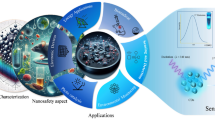Abstract
We report on a method for visual differentiation between the D- and L-forms of tryptophan (Trp). It is based on the inherent chirality of citrate-capped silver nanoparticles (AgNPs; ca. 15 nm in diameter) that can be used as chiral selector for D- and L-forms of Trp. On addition of D-Trp to a solution of the AgNPs, a color change from yellow to red can be seen, while no color change is found on addition of L-Trp. The chiral assay can be used to determine the enantiometric excess of D-Trp in the range from −50 % to 100 %. The effect can be detected with bare eyes and quantified by spectrophotometry. Notably, this method does not require any labeling or chiral modification. The method excels by its sensitivity, low cost, good availability of materials, and its simplicity.

The silver nanoparticles can discriminate the absolute configuration of Trp and determine the enantiomeric excess of Trp









Similar content being viewed by others
References
Hao H, Wang G, Sun J (2005) Enantioselective pharmacokinetics of ibuprofen and involved mechanisms. Drug Metab Rev 37:215–234
Seo SH, Kim S, Han MS (2014) Gold nanoparticle-based colorimetric chiral discrimination of histidine: application to determining the enantiomeric excess of histidine. Anal Methods 6:73–76
Waldhier MC, Gruber MA, Dettmer K, Oefner PJ (2009) Capillary electrophoresis and column chromatography in biomedical chiral amino acid analysis. Anal Bioanal Chem 394:695–706
Ilisz I, Aranyi A, Péter A (2013) Chiral derivatizations applied for the separation of unusual amino acid enantiomers by liquid chromatography and related techniques. J Chromatogr A 1296:119–139
Bodoki E, Oltean M, Bodoki A, Ştiufiuc R (2012) Chiral recognition and quantification of propranolol enantiomers by surface enhanced Raman scattering through supramolecular interaction with β-cyclodextrin. Talanta 101:53–58
Feng W, Liu C, Lu S, Zhang C, Zhu X, Liang Y, Nan J (2014) Electrochemical chiral recognition of tryptophan using a glassy carbon electrode modified with cyclodextrin and graphene. Microchim Acta 181:501–509
Park H, Kim KM, Lee A, Ham S, Nam W, Chin J (2007) Bioinspired chemical inversion of L-amino acids to D-amino acids. J Am Chem Soc 129:1518–1519
Han C, Hou X, Zhang H, Guo W, Li H, Jiang L (2011) Enantioselective recognition in biomimetic single artificial nanochannels. J Am Chem Soc 133:7644–7647
Zhang M, Ye B (2011) Colorimetric chiral recognition of enantiomers using the nucleotide-capped silver nanoparticles. Anal Chem 83:1504–1509
Tu T, Fang W, Bao X, Li X, Dötz KH (2011) Visual chiral recognition through enantioselective metallogel collapsing: synthesis, characterization, and application of platinum–steroid low-molecular-mass gelators. Angew Chem Int Ed 50:6601–6605
Su L, Fei J, Zhou X, Ren C, Li H, Chen X (2012) Colorimetric detection of urine glucose based ZnFe2O4 magnetic nanoparticles. Anal Chem 84:5753–5758
Song Y, Wei W, Qu X (2011) Colorimetric biosensing using smart materials. Adv Mater 23:4215–4236
Zhao W, Brook MA, Li Y (2008) Design of gold nanoparticle-based colorimetric biosensing assays. ChemBioChem 9:2363–2371
Halas NJ, Lal S, Chang W-S, Link S, Nordlander P (2011) Plasmons in strongly coupled metallic nanostructures. Chem Rev 111:3913–3961
Saha K, Agasti SS, Kim C, Li X, Rotello VM (2012) Gold nanoparticles in chemical and biological sensing. Chem Rev 112:2739–2779
Su H, Zheng Q, Li H (2012) Colorimetric detection and separation of chiral tyrosine based on N-acetyl-L-cysteine modified gold nanoparticles. J Mater Chem 22:6546–6548
Sun Y, Zhang L, Li H (2012) Chiral colorimetric recognition of amino acids based on silver nanoparticle clusters. New J Chem 36:1442–1444
Li H, Hu C, Han C, Xiong D, Tian D (2009) Synthesis of β-Cyclodextrin-modified silver quantum dots and chiral colorimetric recognition of tryptophan. Sci China Ser B 39:629–633
Xiong D, Chen M, Li H (2008) Synthesis of para-sulfonatocalix [4] arene-modified silver nanoparticles as colorimetric histidine probes. Chem Commun 44:880–882
Gautier C, Bürgi T (2009) Chiral gold nanoparticles. ChemPhysChem 10:483–492
Noguez C, Garzon IL (2009) Optically active metal nanoparticles. Chem Soc Rev 38:757–771
Zhang L, Xu C, Liu C, Li B (2014) Visual chiral recognition of tryptophan enantiomers using unmodified gold nanoparticles as colorimetric probes. Anal Chim Acta 809:123–127
Wei H, Chen C, Han B, Wang E (2008) Enzyme colorimetric assay using unmodified silver nanoparticles. Anal Chem 80:7051–7055
Kanjanawarut R, Su X (2009) Colorimetric detection of DNA using unmodified metallic nanoparticles and peptide nucleic acid probes. Anal Chem 81:6122–6129
Yguerabide J, Yguerabide EE (1998) Light-scattering submicroscopic particles as highly fluorescent analogs and their use as tracer labels in clinical and biological applications: I. Theory. Anal Biochem 262:137–156
Liu W, Kou J, Jiang X, Zhang Z, Qi H (2012) Determination of nitrofurans in feeds based on silver nanoparticle-catalyzed chemiluminescence. J Lumin 132:1048–1054
McFadden CF, Cremer PS, Gellman AJ (1996) Adsorption of chiral alcohols on “chiral” metal surfaces. Langmuir 12:2483–2487
Pellissier H (2008) Recent developments in dynamic kinetic resolution. Tetrahedron 64:1563–1601
Acknowledgments
This work was supported financially by the National Natural Science Foundation of China (no. 21275096 and 21343015) and the Program for Key Science and Technology Innovation Team of Shaanxi Province (2014KCT-28).
Author information
Authors and Affiliations
Corresponding author
Electronic supplementary material
Below is the link to the electronic supplementary material.
ESM 1
(PDF 180 kb)
Rights and permissions
About this article
Cite this article
Liu, C., Li, B. & Xu, C. Colorimetric chiral discrimination and determination of enantiometric excess of D/L-tryptophan using silver nanoparticles. Microchim Acta 181, 1407–1413 (2014). https://doi.org/10.1007/s00604-014-1281-y
Received:
Accepted:
Published:
Issue Date:
DOI: https://doi.org/10.1007/s00604-014-1281-y




